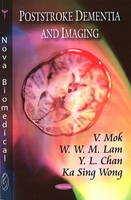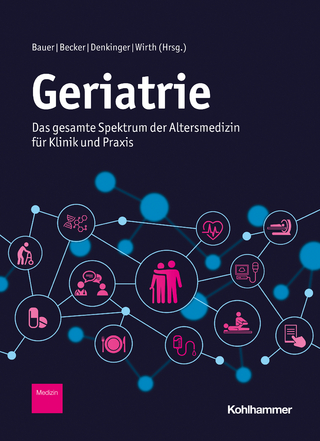
Poststroke Dementia & Imaging
Seiten
2009
Nova Science Publishers Inc (Verlag)
978-1-60692-247-7 (ISBN)
Nova Science Publishers Inc (Verlag)
978-1-60692-247-7 (ISBN)
- Titel ist leider vergriffen;
keine Neuauflage - Artikel merken
Stroke increases the risk of dementia by approximate 2-9 times. World wide, vascular dementia (VaD) is the second commonest cause of dementia. Presence of post-stroke dementia (PSD) reduces survival among stroke survivors and increases risk of long term stroke recurrence. This title intends to review the understanding of PSD and its imaging.
Stroke increases the risk of dementia by approximate 2-9 times. World wide, vascular dementia (VaD) is the second commonest cause of dementia. Presence of post-stroke dementia (PSD) reduces survival among stroke survivors and increases risk of long term stroke recurrence. Varying severity levels of cognitive impairment affects functional outcome independent of physical impairment. With an ageing population, burden of PSD is expected to rise. Although PSD is prevalent, relevant to mortality and morbidity, and is potentially more preventable than Alzheimer's disease (AD), it has received less attention relative to post-stroke physical impairment or to AD. It is not until the last decade that more attention has been paid to PSD. Historically, in the late 19th century, VaD was considered to be the commonest cause of dementia. It was thought that dementia was due to a relentless strangulation of the brain's blood supply, resulting in degeneration of the brain and dementia. In the middle of the 20th century, pathological studies have begun to reveal that senile plaques and neurofibrillary tangles, rather than vascular lesions, were key findings among most of the elderly demented patients with atrophic brains. In the early 70s, VaD was thought to be uncommon and the mechanism of VaD was attributed to multiple small or large cerebral infarcts (multi-infarct dementia). In recent decades, advances of neuroimaging have enhanced greatly our understanding on VaD, its complexity far exceeds that of the concept of multi-infarct dementia. The authors aim to review the current understanding of PSD and its imaging. Poststroke dementia will first be defined. Following that, foundational issues of PSD including its classification, pathology, prevalence, and cognitive pattern will be reviewed. This sets the background for discussing the imaging aspects relevant to PSD.
Stroke increases the risk of dementia by approximate 2-9 times. World wide, vascular dementia (VaD) is the second commonest cause of dementia. Presence of post-stroke dementia (PSD) reduces survival among stroke survivors and increases risk of long term stroke recurrence. Varying severity levels of cognitive impairment affects functional outcome independent of physical impairment. With an ageing population, burden of PSD is expected to rise. Although PSD is prevalent, relevant to mortality and morbidity, and is potentially more preventable than Alzheimer's disease (AD), it has received less attention relative to post-stroke physical impairment or to AD. It is not until the last decade that more attention has been paid to PSD. Historically, in the late 19th century, VaD was considered to be the commonest cause of dementia. It was thought that dementia was due to a relentless strangulation of the brain's blood supply, resulting in degeneration of the brain and dementia. In the middle of the 20th century, pathological studies have begun to reveal that senile plaques and neurofibrillary tangles, rather than vascular lesions, were key findings among most of the elderly demented patients with atrophic brains. In the early 70s, VaD was thought to be uncommon and the mechanism of VaD was attributed to multiple small or large cerebral infarcts (multi-infarct dementia). In recent decades, advances of neuroimaging have enhanced greatly our understanding on VaD, its complexity far exceeds that of the concept of multi-infarct dementia. The authors aim to review the current understanding of PSD and its imaging. Poststroke dementia will first be defined. Following that, foundational issues of PSD including its classification, pathology, prevalence, and cognitive pattern will be reviewed. This sets the background for discussing the imaging aspects relevant to PSD.
Preface; Introduction; Defining Poststroke Dementia; Classification of Poststroke Dementia; Pathology of Poststroke Dementia; Frequency, Incidence, and Clinical Determinants of Poststroke Dementia; Cognitive Pattern of Poststroke Dementia; Imaging in Poststroke Dementia; Basic Imaging Modalities and Methods in Poststroke Dementia; Imaging Determinants for Ischemic Poststroke Dementia; Recent Imaging Applications in PSD; Take-Home-Messages; Index.
| Erscheint lt. Verlag | 1.1.2009 |
|---|---|
| Zusatzinfo | Illustrations, unspecified |
| Verlagsort | New York |
| Sprache | englisch |
| Maße | 230 x 155 mm |
| Gewicht | 190 g |
| Themenwelt | Medizin / Pharmazie ► Medizinische Fachgebiete ► Geriatrie |
| ISBN-10 | 1-60692-247-5 / 1606922475 |
| ISBN-13 | 978-1-60692-247-7 / 9781606922477 |
| Zustand | Neuware |
| Haben Sie eine Frage zum Produkt? |
Mehr entdecken
aus dem Bereich
aus dem Bereich
das gesamte Spektrum der Altersmedizin für Klinik und Praxis
Buch | Hardcover (2024)
Kohlhammer (Verlag)
189,00 €
Das Wichtigste für Ärztinnen und Ärzte aller Fachrichtungen
Buch | Softcover (2021)
Urban & Fischer in Elsevier (Verlag)
37,00 €


